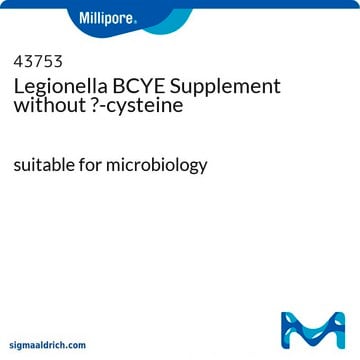0797
GVPC Agar

ready-to-use, plate of 20 × 23 ± 1 mL, selective for bacteria: Legionella spp
Sign Into View Organizational & Contract Pricing
All Photos(1)
About This Item
UNSPSC Code:
41106217
Recommended Products
Agency
ISO 11731
form
plate (Semi-solid Media Filled)
feature
ready-to-use
packaging
plate of 20 × 23 ± 1 mL
technique(s)
microbiological culture: suitable
plate size
90 mm
pH
6.9 ± 0.2 (25 °C)
application(s)
food and beverages
water monitoring
storage temp.
2-8°C
suitability
selective for bacteria: Legionella spp
Related Categories
General description
GVPC Agar, also known as Glycine-vancomycin-polymyxin-cycloheximide agar, is a Ready-to-Use media designed as per ISO Standards 11731 to detect Legionella spp.
The activated carbon in GVPC agar has an antitoxic effect due to the adsorption of fatty acids, but especially due to the breakdown of oxygen radicals and H2O2. Yeast extract provides the necessary proteins and nutrients. L-cysteine is an essential growth factor for all Legionella. The soluble iron (III) pyrophosphate [Fe4(P2O7)3] is used as a special iron source, whose quality significantly affects the growth of the Legionella. α-ketoglutarate stimulates the growth of legionella both as a carbon and nitrogen source (Krebs Cycle) as well as through mediation of the iron transport, the high amount of glycine and polymyxin B act against gram-negative, Vancomycin act against gram-positive bacteria of the accompanying bacterial flora. Cycloheximide acts fungicidal against both yeasts and molds. Thus, the selectivity of the medium is increased.
The activated carbon in GVPC agar has an antitoxic effect due to the adsorption of fatty acids, but especially due to the breakdown of oxygen radicals and H2O2. Yeast extract provides the necessary proteins and nutrients. L-cysteine is an essential growth factor for all Legionella. The soluble iron (III) pyrophosphate [Fe4(P2O7)3] is used as a special iron source, whose quality significantly affects the growth of the Legionella. α-ketoglutarate stimulates the growth of legionella both as a carbon and nitrogen source (Krebs Cycle) as well as through mediation of the iron transport, the high amount of glycine and polymyxin B act against gram-negative, Vancomycin act against gram-positive bacteria of the accompanying bacterial flora. Cycloheximide acts fungicidal against both yeasts and molds. Thus, the selectivity of the medium is increased.
Application
Glycine Vancomycin Polymyxin Cycloheximide (GVPC) Agar is a selective culture medium used for the isolation, detection and enumeration of Legionella spp. in water samples from various sources (water intended for human consumption, wastewater, thermal and mineral waters, etc.) and food and beverage samples.
Certificates of Analysis (COA)
Search for Certificates of Analysis (COA) by entering the products Lot/Batch Number. Lot and Batch Numbers can be found on a product’s label following the words ‘Lot’ or ‘Batch’.
Already Own This Product?
Find documentation for the products that you have recently purchased in the Document Library.
Our team of scientists has experience in all areas of research including Life Science, Material Science, Chemical Synthesis, Chromatography, Analytical and many others.
Contact Technical Service



